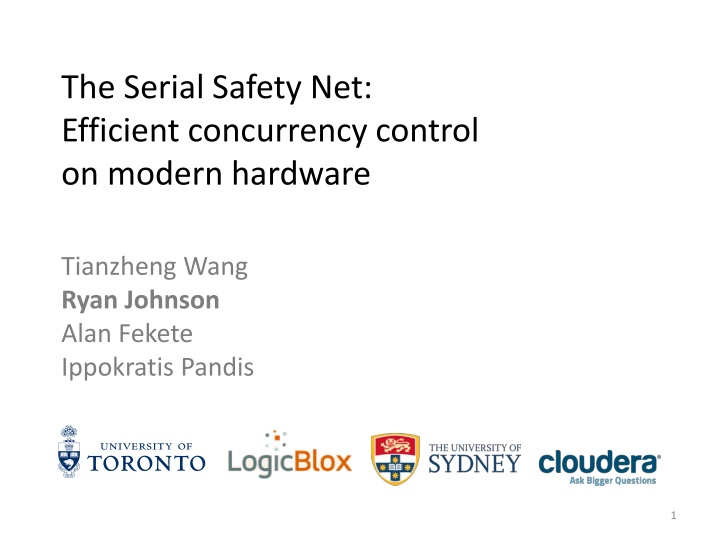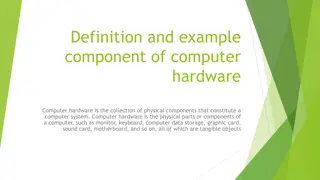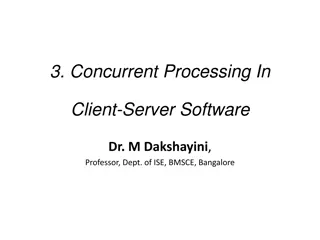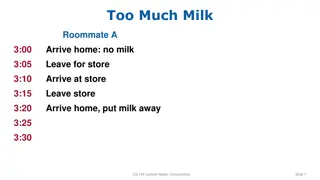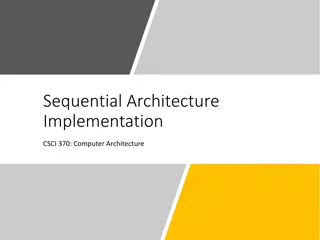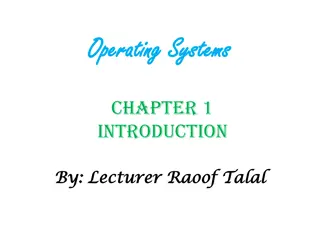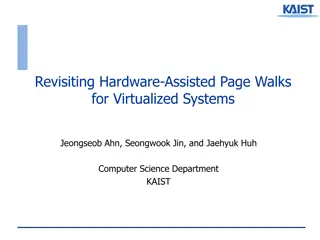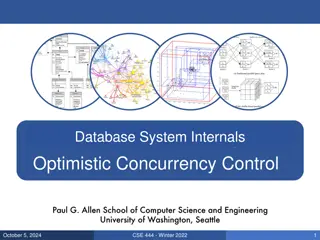Efficient Concurrency Control on Modern Hardware
This research explores efficient concurrency control mechanisms on modern hardware, addressing issues related to CPU utilization, locks, threads, memory management, and disk operations. It delves into the current state-of-the-art techniques and the importance of robustness in ensuring fast, fair, and serializable transaction processing. The Serial Safety Net (SSN) is introduced as a method to dictate access patterns and handle anomalies in execution. The study also examines database models, serialization graphs, and cycles in the context of concurrency control.
Download Presentation

Please find below an Image/Link to download the presentation.
The content on the website is provided AS IS for your information and personal use only. It may not be sold, licensed, or shared on other websites without obtaining consent from the author.If you encounter any issues during the download, it is possible that the publisher has removed the file from their server.
You are allowed to download the files provided on this website for personal or commercial use, subject to the condition that they are used lawfully. All files are the property of their respective owners.
The content on the website is provided AS IS for your information and personal use only. It may not be sold, licensed, or shared on other websites without obtaining consent from the author.
E N D
Presentation Transcript
The Serial Safety Net: Efficient concurrency control on modern hardware Tianzheng Wang Ryan Johnson Alan Fekete Ippokratis Pandis 1
Modern HW: CPU on critical path Modern DBMS Classic DBMS Locks Disks Threads Memory Disk Threads Low parallelism Focus: hide I/O stalls High parallelism Focus: minimize cycles Main-memory OLTP: more pressure on CC 2
CC: current state of the art 0.5 Contentious TPC-C variant SSI (slow) 0.4 Aborts/commit OCC (fast) 0.3 6 12 16 24 0.2 0.1 SI (non-serializable) 1 0.0 0 100 200 Throughput (ktps) 300 400 500 OCC looks good. What s the problem? 3
CC: Robustness matters! 4.0 Contentious TPC-C variant with retries 6 SSI (slow) 3.0 Aborts/commit 12 2.0 OCC (unfair) 16 SI (non-serializable) 24 1.0 1 0.0 0 100 200 300 400 Throughput (ktps) Need all three: fast, fair, serializable 4
The Serial Safety Net (SSN) Dictates access pattern Aborts offenders Some CC >= RC SSN Might admit anomalies Serializable execution Cheap certifier Works even if CC is buggy 5
SSN: fast, fair, serializable 4.0 SSI 3.0 Aborts/commit 2.0 SI OCC SSN 1.0 0.0 0 100 200 300 400 Throughput (ktps) 6
Database model CC decides which version to read Multi-version database R4 R1 R2 R3 R1 R1 R3 Invisible to other readers Uncommitted write Captures most CC schemes, incl. 2PL 7
Serialization graphs and cycles T1 r(x,0) r(y,0) w(x,-11) C!! T2 r(y,0) w(y,10) C!! T3 r(x,0) r(y,10) C!! T1 r:y:w T2 w:x:r T3 r:x:w T1 SI read-only anomaly y commit time T1 T1 T2 T2 (T3) T3 x x dependency order T3 8
Serialization graphs and cycles T1 commits last & closes the cycle Hard to detect T1 T3 Easy to detect T3 T1 commit time T1 T2 (T3) T3 SSN: efficiently detect T1 T3 dependency order 9
SSN in a nutshell Track T s earliest successor Define c(T) = commit time of T P might be a successor of T Define (T) = min {c(S) : T S} T might close a cycle Forbid P T : (T) c(P) c(T) exclusion window of T 10
Visualizing SSN T4 T2 T1 T3 T1 (T1) (T4) T2 T4 (T2) T3 T5 Exclusion window satisfied T2 T2 commit time T4 ?? T1 T1 (T2) (T2) T3 Exclusion window violation dependency order 11
Evaluation System 4 x 6-core Xeon @ 1.8GHz, 64GB DRAM A variant of Silo* that supports SI and RC TPC-C w/ random warehouse selection RC, SI, OCC (Silo), SSI, {SI, RC} + SSN What to test General performance/scalability Fairness for updates vs. reads Robustness under retries * Tu et al, Speedy transactions in multicore in-memory databases , SOSP`13 12
SSN performs well Higher is better OCC SSI Low implementation overhead 13
SSN has low abort rate Lower is better SSI OCC SI (higher) and RC/SI+SSN SSN allows more valid schedules than SSI or OCC 14
SSN provides saferetry Higher is better SI (highest) and RC/SI+SSN SSI OCC 15
SSN is fair OCC starves readers SSI starves writers SSN fair to both R & W % of total commits 100 80 Delivery New-Order Order-Status Payment Stock-Level 60 40 20 0 Ideal Ideal OCC SSI SI SI+SSN RC+SSN OCC SSI SI+SSN SI RC+SSN 16
Conclusion Modern HW puts more pressure on CC No tolerance for CC with heavy touch Serializability becomes even harder Serial safety net a cheap certifier Serializable Compatible with various CC schemes Lightweight and balanced Formal proofs (+ more details) in our paper Thank you! 17
